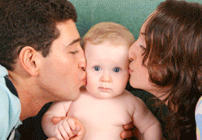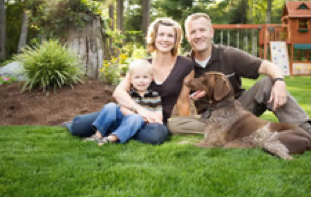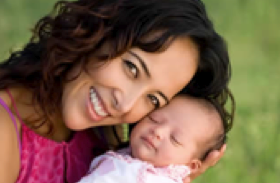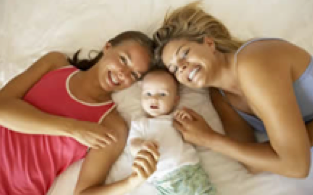The Family
When men and women are pictured together or when men and women are pictured together with children, there is another kind of instruction occurring. These pictures instruct audiences about families. They show the relationships between mothers, fathers, and children. In all categories of ART company websites, the most common and, thus, "normal," picture of family—when couples are pictured together or together with children—is the nuclear, heterosexual family. In these pictures, men/fathers are usually taller, leaned on by women/mothers, and/or observe interactions between mothers and children, and often act like their protectors. In these pictures, the positions of father reflect their power within and over the family.
While few websites present pictures of the family, when the family is presented a common setting or context for the picture is nature (see Table 6). What is happening is similar to what Diane S. Hope (2004) describes about gender and environment. For her the rhetoric of gendered environments or the way gender is portrayed in pictures in certain contexts supports the “belief in distinct gender attributes as essential to sexual identity, and belief in an infinite and unchanging natural world” (p. 156). She writes that women interact passively with the environment and that “many advertising images merge natural scenes with a female form or body part, creating a visual metaphor of woman as nature, nature as woman” (p. 157-58). Instead of a visual metaphor of “woman as nature, nature as woman,” an audience is presented a visual metaphor of heterosexual family as nature, nature as heterosexual family. The instructions tell us that ART processes create "natural" families and "natural" families are nuclear and heterosexual.
There are a few ART company websites that present counterexamples to the traditional notion of the heterosexual family where men and women are pictured as behaving symmetrically—neither men nor women are in positions of dominance or protectiveness (see Figure 11)6. These counterexamples reflect equality between parents and offer a different way to imagine family. These pictures are transformative in how mothers and fathers are not shown in stereotypical roles. Both parents seem to have equal power in the pictures. Fathers are not put in poses where he has the most power (i.e. men are not in protective positions behind women). Still, the overall instructions for audiences are to emphasize heterosexuality and men's power. The message that comes across is that "normal" families are heterosexual families and men still have the most power in these families.
Figure 11: Counterexamples to traditional heterosexual family

from Conceptual Options

from Egg Donor
and Surrogacy Program
Although ART processes disrupt heterosexuality as the only instruction for a normal family, pictures of LGBTQ families are the rarest types of pictures on ART company websites. When these pictures are compared to traditional family pictures, it becomes even more apparent that heterosexual families are "normal" and "natural." I found one unambiguous picture of an LGBTQ family outside of GG, which has four unambiguous pictures of LGBTQ families7. Fairfax Cryobank offers a picture of a lesbian couple with a child (see Figure 12). This picture occurs in contrast to a picture of a heterosexual family and single mother.
Figure 12: Fairfax Cryobank and the family

heterosexual family

single mother

lgbtq family
The verbal text for each picture indicates that Fairfax Cryobank caters to “families” and “single mothers” and “LGBTQ." The pictures representing these populations reveal how Fairfax Cryobank views queer families. The heterosexual family is traditional and nuclear. The mother holds the child and is protected by the father. It occurs in a backyard, in nature. The single mother nuzzles her child in what looks like a yard, in what looks like a natural environment or at least as natural as a park setting can be considered. The traditional family and single heterosexual mothers are framed as "natural" or "normal" families. The lesbian couple representing LGBTQ, on the other hand, is pictured nuzzling a child on a bed. While there is equality in the positions of the parents—neither is taller or in a dominant position, the setting is problematic. It occurs in a room, an artificial construction. And it occurs on a bed. There are sexual connotations in this picture of the lesbian couple. Though nuzzling is "normal" parenting behavior for women, the lesbian couple is associated with unnatural environments and their “abnormal” sexual practices are emphasized. Because the equality between the positions of partners occurs in an "unnatural" environment, this equality is also associated with being "unnatural."
GG’s representations of LGBTQ family are different from Fairfax Cryobank’s representations (see Figure 13). GG, like Fairfax Cryobank, is “dedicated to serving the gay and lesbian community” and "serves all family types regardless of marital status or sexual orientation." And, like Fairfax Cryobank, GG’s pictures of LGBTQ families reveal how GG views these families. Unlike Fairfax Cryobank, GG presents pictures of LGBTQ families in a number of ways—in natural and domestic contexts and without context. For GG, such families are another version of family performing in a number of contexts. Moreover, pictures of LGBTQ family can be read as challenges to The Family in how, for example, men can be pictured as both protectors and protected rather than as primarily powerful protectors of family.
Figure 13: GG's heterosexual family in context and LGBTQ families out of context and in context

heterosexual family in
domestic
context

lgbtq family

lgbtq family
in nature context
Still, the overall instructions for readers when traversing ART company websites is that to be a "natural" or "normal" family in ART company websites is to conflate natural and cultural conventions. To be a "natural" and "normal" family continues to mean heterosexuality. It means traditional gender roles are still the primary heuristics for parenthood. The presence generated for alternative families through their representations maintains their marginality, their artificial character. What is occurring with family is similar to what Judith Butler (2004) observes about social performances and gender:
That gender reality is created through sustained social performances means that the very notions of an essential sex and a true or abiding masculinity or femininity are also constructed as part of the strategy that conceals gender’s performative character and the performative possibilities of proliferating gender configurations outside the restricting frames of masculinist domination and compulsory heterosexuality. (p. 115)
The pictures of family can be considered heuristics of social performances creating a gender reality. As instructions for family, ART company website pictures may not always conceal alternative representations of family; however, pictures of alternative representations of family are not just limited in number, they can be visually restrictive and continue to frame “true” or “correct” answers to questions assessing family as masculine/father dominated and heterosexual. With the exception of GG, commonplace instruction or rule of thumb for family is LGBTQ family is strange. Heterosexual family is natural.
6 I found seven alternative pictures of heterosexual families coming from six ART company websites. Building Families and Family Creations have alternative pictures of family that could be considered traditional family since the couples do show relative size differences. These pictures, however, are unique. In Building Families' picture the woman wraps her hand around the man and there is not body canting. In Family Creations, there is size difference but no canting and the couple is walking together much like the example from The Egg Donor and Surrogacy Program. I consider these transformative representations when compared to others. For me, relative size is not as dramatic a representation of power as canting or "shoulder holding" in family contexts.
7 My use of LGBTQ is somewhat misleading regarding GG. I am using this as an inclusive term as GG's verbal text indicates with regards to their audience. GG's unambiguous (i.e. body positions and proximity indicated individuals were couples) of LGBTQ family are all of gay men.
Table 6: The family and the contexts in which the family occurs*
Return to text
| Sperm | Egg | Surrogacy** | Egg and Surrogacy | Sperm and Egg (NAC) | Sperm, Egg, and Surrogacy (GG) | Total no. | |
|---|---|---|---|---|---|---|---|
| No. of sites with the family | 4/8 | 1/6 | 1/2 | 7/10 | 0/1 | 1/1 | 14/28 |
| Domestic | 0 | 0 | 0 | 4 | 0 | 2 | 6 (14.3) |
| Hospital | 0 | 0 | 4 | 0 | 0 | 0 | 4 (9.5) |
| Nature | 1 | 2 | 3 | 9 | 0 | 0 | 15 (35.7) |
| Urban | 0 | 0 | 1 | 0 | 0 | 0 | 1 (2.4) |
| No-context | 5 | 2 | 1 | 5 | 0 | 3 | 16 (38.1) |
*Heterosexual family pictures that seem to challenge traditional family pictures are included in the totals. The contexts of these family pictures are important for understanding how heterosexual families are represented regardless of parenting behavior or pose in the picture is traditional or non-traditional.
**Building Families’ website does have pictures of a new sort of family not counted in these totals where recipients and surrogates pose together. This sort of picture is discussed later.

